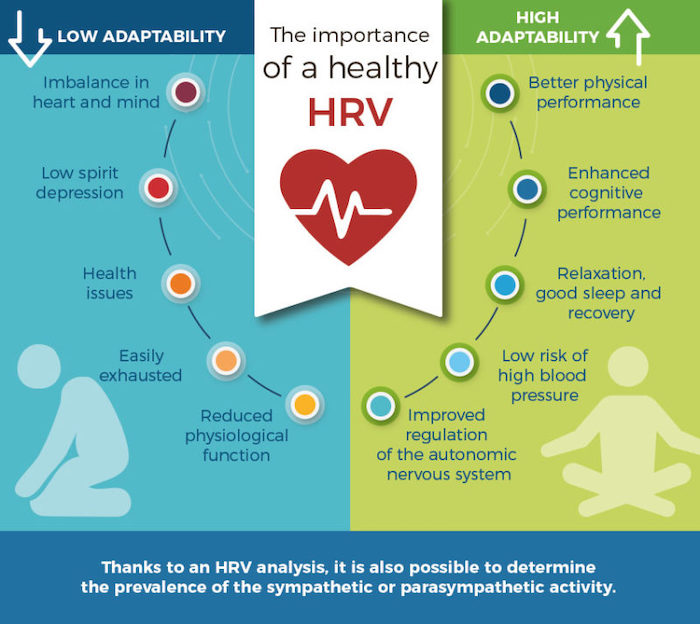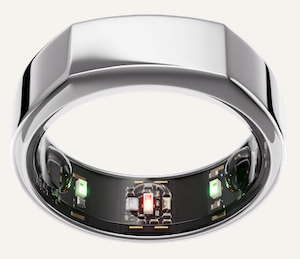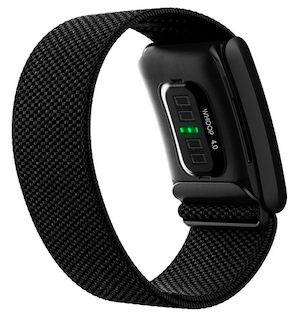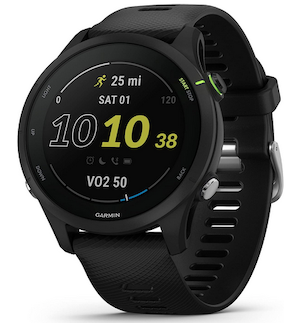Low HRV? What You Need to Know to Become Metabolically Fit
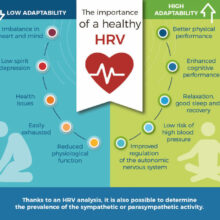
Low HRV (heart rate variability) will mess with your health. A HRV score that’s too low might be connected to a host of maladies, from high glucose to metabolic syndrome. It’s a good idea to know what your average HRV score is, and that’s what this post is all about.
The perils of low HRV is something we need to know about if living a long and strong life is something you  want. I’ve known a bit about HRV for some time, but it was only after I bumped into a ten-year old study the other day, courtesy of @agingdoc1, who I follow on Twitter. It was the first study that clearly showed the correlation between heart rate variability (HRV), glycemic status independent of metabolic syndrome components and inflammation.
want. I’ve known a bit about HRV for some time, but it was only after I bumped into a ten-year old study the other day, courtesy of @agingdoc1, who I follow on Twitter. It was the first study that clearly showed the correlation between heart rate variability (HRV), glycemic status independent of metabolic syndrome components and inflammation.
Intrigued, I searched for newer studies that more broadly have investigated the connection between a person’s HRV and anything pathological, or associated with overall fitness, or the aging processes.
I found a lot. This is stuff you need to know about in order to monitor and manage your HRV.
Content: HRV, glycemic status and metabolic syndrome What is heart rate variability? What is metabolic syndrome? HRV, heart disease, etc. How you can measure and improve your low HRV Personal HRV tracking devices to consider Your Takeaway
Let’s begin with the study that jumped started this whole investigation. It’s entitled, Heart Rate Variability is Associated with Glycemic Status After Controlling for Components of the Metabolic Syndrome.
That’s next up…
Findings of the 2012 HRV/Metabolic Study
The 2012 HRV/metabolic study paper aimed to evaluate the relationship between HRV and glycemic status after controlling for metabolic syndrome (MetS) in a healthy working cohort of 2,441 study participants, aged 17 to 65.
Heart rate variability (HRV) is a measure of the variation in time between successive heartbeats, which is influenced by the autonomic nervous system. Metabolic syndrome (MetS) is a cluster of conditions that increase the risk of heart disease, stroke, and diabetes. (More about both of those below.) The components of MetS include abdominal obesity, high blood pressure, high blood sugar, high triglycerides, and low HDL cholesterol.
OK, so now you know a bit about what HRV is and its importance, but why connect that in some fashion to “glycemic status”?
According to the WHO, glycemic status refers to a person’s fasting blood glucose (blood sugar). The expected values for normal fasting blood glucose concentration are between 70 mg/dL (3.9 mmol/L) and 100 mg/dL (5.6 mmol/L). When fasting blood glucose is between 100 to 125 mg/dL (5.6 to 6.9 mmol/L) changes in lifestyle and monitoring glycemia (blood glucose levels) are recommended.
The study in question found:
- A negative correlation between HRV and glycemic status that appeared to be almost linear in its large cohort of healthy workers; and that
- Reduced heart rate variability is related to the number of metabolic syndrome components (see graphic below) and manifest diabetes (is it present or not).
Again, this study was the first to find that HRV is negatively correlated with glycemic status after controlling for MetS, and that reduced HRV is related to the number of MetS components and manifest diabetes.
That’s a big deal!
The percentage of Americans and Europeans with high blood sugar is significant, with 11.3% of Americans and 6.2% of Europeans having diabetes, and another 84.1 million Americans and 24.2 million Europeans having prediabetes or undiagnosed diabetes [1][2][3][4].
You’ve probably heard a lot about how diet and exercise improves glucose markers and the various components that makeup metabolic syndrome, but HRV? Yeah, I didn’t get the full scope of its relevance till recently.
Obviously, HRV, especially low HRV, is worth knowing about if we want to stride into old age fit as a fiddle.
What Is Heart Rate Variability?
Heat rate variability (HRV) refers to the variation in the time interval between consecutive heartbeats. It’s influenced by the autonomic nervous system, which regulates the balance between the sympathetic and parasympathetic branches of the nervous system. (The sympathetic nervous system is a network of nerves that helps your body activate its “fight-or-flight” response., and the parasympathetic is a network of nerves that relaxes your body after periods of stress or danger.) HRV is considered a noninvasive measure of autonomic nervous system activity and has been linked to various health conditions.
HRV is measured by calculating the time between successive heartbeats. The standard method to measure HRV is through an electrocardiogram (ECG), which records the electrical activity of the heart; however, there are also wearable devices, such as smartwatches and chest strap heart rate monitors, that can measure HRV [5].
HRV scores are highly individualized and can vary depending on age, fitness level, and other factors, such as time of day, the way your nervous system typically responds to stressful situations, and much more. A “good” HRV score is relative for each person, but the general consensus is that a consistent baseline score of 70 or higher is associated with health; whereas levels between 50 and 70 are compromised health and diseases, says Caring Medical.
Caring Medical is a medical clinic focused on Regenerative Medicine. It’s piece about HRV underscores that a high HRV demonstrates the resiliency of your body to cope with “fight-flight” or danger, stress and anxiety, but also be able to calm down afterwards.
A HRV indicates an ability to manage stressful situations. Alternatively, a low HRV has been confirmed in numerous studies to be a strong, independent predictor of future health problems and as a correlate of all-cause mortality. A low HRV demonstrates the lack of resiliency of your body to cope with “fight-flight” or danger, stress and anxiety.
Reduced HRV has been shown to occur in about every illness in man, woman, child, neonate and even fetuses.
Dr. Ross A. Hauser from Caring Medical provides a thorough review of HRV in the five minute video below:
Here are some general guidelines for good and bad HRV scores relative to a person’s age and fitness level:
- For adults, a good HRV score is generally considered to be above 50 ms, while a bad HRV score is below 50 ms [6][7].
- For older adults, a good HRV score is generally considered to be above 25 ms, while a bad HRV score is below 15 ms [6].
- For children, a good HRV score is generally considered to be above 80 ms, while a bad HRV score is below 60 ms [7].
- For athletes, a good HRV score is generally considered to be above 80 ms, while a bad HRV score is below 60 ms [8].
It’s important to note that these are general guidelines, and HRV scores can vary widely depending on the individual. Additionally, HRV scores can fluctuate throughout the day and from one day to the next, so it’s important to track HRV over time to get a better understanding of an individual’s baseline HRV score [7].
What Is Metabolic Syndrome?
Metabolic syndrome is a cluster of metabolic abnormalities, including central obesity, high blood pressure, high blood sugar levels, abnormal lipid levels, and insulin resistance. It’s associated with an increased risk of developing cardiovascular disease and type 2 diabetes.
For more about metabolic syndrome, read my post, Metabolically Unfit? Most Americans Are!.
Here are some important things to know about metabolic syndrome:
- Metabolic syndrome is a common condition that affects millions of people in the United States and Europe.
- The exact cause of metabolic syndrome is not known, but it is believed to be related to insulin resistance, which is when the body does not respond properly to insulin.
- Metabolic syndrome increases the risk of developing heart disease, stroke, and diabetes.
- The risk of developing metabolic syndrome is higher in people who are overweight or obese, have a family history of diabetes or heart disease, or have certain ethnic backgrounds.
- Lifestyle changes, such as losing weight, exercising regularly, and eating a healthy diet, can help prevent or manage metabolic syndrome.
- Treatment for metabolic syndrome may include medications to control blood pressure, cholesterol, and blood sugar levels.
OK, so far we get that low HRV can play havoc on our glycemic statu and increase our chances of getting the dreaded metabolic syndrome. But what else is associated with low HRV? A lot, including some of the individual metrics that make up metabolic syndrome, as you’ll soon see.
HRV Is Also Connected to Obesity, Heart Disease and More
We addressed HRV and its relationship to glucose and metabolic syndrome, but it’s connected to more health issues than that. For instance, although metabolic syndrome is defined as having one or more of the five indices shown above in the infographic. Some of those five all by themselves are correlated to low HRV, such as obesity, cardiovascular disease, high blood pressure and insulin resistance.
A 2022 study that evaluates the association between metabolic syndrome components and cardiac issues aimed to investigate differences in HRV in healthy, metabolic syndrome (MetS), and diabetic populations. The study found a significant negative association between HRV and the number of MetS components and manifest diabetes. The study concluded that:
Reduced HRV is related to the number of MetS components and manifest diabetes, and HRV can be used to monitor the activity of the autonomic nervous system (ANS) and study the progression of ANS-related diabetes complications.
Another study published in 2019 examined the impact of low HRV on aging and the metabolic impact of obesity, and found that:
Lower HRV is a risk factor for mortality and it precedes the appearance of many modifiable and non-modifiable risk factors for the development of cardiovascular diseases.
The study also found that the connection between obesity and low parasympathetic activity estimated through HRV is found in the early period of life.
Associations between cardio metabolic risk factors (CMRF) with HRV revealed a higher cardio metabolic risk score, and blood pressure and insulin levels were associated with low HRV [9].
Since the 2012 study that we began with above, many subsequent studies have affirmed that HRV is correlated with many health factors besides glycemic status, such as:
Obesity: Investigations have shown that decreased HRV is associated with obesity [10]. Physiological variation in the time interval between heartbeats (HRV) is pathologically decreased in individuals with cardiovascular diseases. Moreover, the probability of developing obesity-related cardiovascular diseases — as well as the risk of all-cause mortality — can be measured by HRV [11]. One study found that the relationship between HRV and adiposity differs for central (around the middle) and overall adiposity (body fat) [12]. Reduced HRV is connected to a higher level of obesity, hypertension, coronary heart disease, diabetes, hyperlipidemia, and other components of metabolic syndrome [13].
Insulin resistance: Decreased HRV has been associated with insulin resistance [10].
Metabolic syndrome: Reduced HRV is related to the number of metabolic syndrome components and manifest diabetes [13][14]. A systematic review of 14 studies found that HRV is associated with metabolic syndrome, decidedly affirming the results of the 2012 study first reviewed above [10].
Cardiovascular diseases: Abnormal autonomic regulation, estimated through HRV, is ever more cited as a link between metabolic disorders and cardiovascular events. Lower HRV is a risk factor for mortality and it precedes the appearance of many modifiable and non-modifiable risk factors for the development of cardiovascular diseases [13].
The bottom line is that a low HRV score has been found to be negatively correlated with several factors besides glycemic status, including obesity, insulin resistance, metabolic syndrome, and cardiovascular diseases.
How You Can Measure and Improve Your Low HRV
 As the saying goes, You can’t manage what you don’t measure, so the first thing to do is to measure your HRV, and then, if you have a low HRV, take action to improve it.
As the saying goes, You can’t manage what you don’t measure, so the first thing to do is to measure your HRV, and then, if you have a low HRV, take action to improve it.
Measure your HRV
Earlier, I touched on some ways that HRV is measured, but here’s a closer look.
There are four ways you can measure your heart rate variability (HRV):
1. Electrocardiogram (ECG): This is the most accurate way to measure HRV, but it requires a medical professional and specialized equipment [15][16].
2. Photoplethysmography (PPG): This is a new method of measuring HRV that uses an optical sensor to measure inter-beat intervals [17]. It is less accurate than ECG but can be done at home with a smartphone or smartwatch that offers this measurement.
3. Personal chest strap monitor: This is a wearable device that measures HRV using an ECG or PPG sensor [18][19]. Chest strap monitors are more accurate than wrist-worn devices, but they can be uncomfortable to wear for long periods.
4. Smartwatch or fitness tracker: Many smartwatches and fitness trackers have built-in HRV sensors that use PPG to measure inter-beat intervals [20][16]. These devices are convenient and easy to use, but they are not yet as accurate as chest strap monitors or ECGs.
Let’s look at some brands that do a good to reasonable job at monitoring and reporting HRV, as well as several other health/fitness metrics. Note, however, that the current gold standard for measuring HRV — ECG electrodes — is only used in the Polar H10 in this list.
The Polar H10 is considered the most accurate wearable device for measuring HRV when compared to criterion measures, given that it uses ECG electrodes [21]. You get HRV accuracy, but the limitations of the Polar H10 are that you (1) Either must wear it around your arm or chest, so wearing it while you sleep is not ideal; and (2) It must be paired with a smartwatch to enable the raw data to be extracted for HRV analysis, which incurs additional cost if you don’t already have a smartwatch.
The Oura Ring is a smart ring that tracks HRV and other metrics. It’s designed to sample your heart rate multiple times per second, and can record how much variance there is in the time between each beat of your heart [22]. It’s a pricey device, but it provides a comprehensive set of HRV analytics.
The Whoop Band is a fitness band that monitors and improves HRV. It is designed to track HRV 24/7 and provides personalized recommendations based on your HRV data [23]. A subscription is required and the band itself is not cheap. instead of an electrocardiogram (ECG), WHOOP tracks your heart rate via a photoplethysmography (PPG), which is purported to be more accurate [24].
The Apple Watch has a built-in optical heart rate sensor that continuously records HRV when you wear it, of course, and lets you view trends inside the Apple Health app on your paired iPhone [25]. It also has third-party HRV apps like HRV4Training that can help you interpret the data and offer more actionable data.
Garmin smartwatches are designed to sample your heart rate multiple times per second and can record HRV [22]. The Forerunner 255 gives HRV insights on-screen through the “Morning Report” feature [26]. The HRV data requires going into the app, as opposed to being displayed on the watch face.
To summarize: the Polar H10 is considered the most accurate wearable device for measuring HRV, while the Oura Ring provides a comprehensive set of HRV analytics. The Whoop Band is designed to track HRV 24/7 and provides personalized recommendations based on your HRV data. The Apple Watch and Garmin smartwatches have built-in HRV sensors, but their accuracy may not be as high as devices that use ECG electrodes.
Hopefully, your HRV will be in a healthy range. Remember, you need a few weeks of data to know your average score, given that HRV will fluctuate, particularly during periods of stress or poor sleep. If you discover that you have low HRV, time to get cracking.
Improve your HRV score
Heart rate variability (HRV) can be improved through various lifestyle changes. This is not an exhaustive list, but there’s plenty here to get you started:
Get consistent, quality sleep: Restful, restorative sleep is one of the most important levers for improving HRV and overall wellbeing [27][28].
A study published earlier this year (2023) entitled, The role of sleep and heart rate variability in metabolic syndrome: evidence from the Midlife in the United States study, concluded:
“… poor sleep and low HRV were both associated with metabolic syndrome and that the odds of metabolic syndrome were strongest among those with both poor sleep quality and low HRV… These findings highlight the potential for targeting both HRV and sleep to noninvasively reduce or prevent cardiometabolic and related chronic diseases.”
Read my post: 7 Sleeping Tips for Your Ultimate Rest and Restoration.
By the way, remember if you a “smart watch” or fitness band, it might be able to track your HRV, so get into the habit of checking that each morning.
Focus on your breathing: Breathing exercises, such as deep breathing, can help improve HRV by activating the parasympathetic nervous system [27].
Exercise regularly: Exercise can improve heart health and overall health, which can lead to an increased HRV [27][29][30].
Need some exercise guidance? I’ve got you covered!
Manage stress: Managing daily stressors can help increase HRV [29].
Lotsa tips about de-stressing here.
Prioritize diet and nutrition: Eating a nutritious diet and avoiding refined carbs and sugars can help improve HRV [27][30][31].
Yep, gotcha covered!
Stay hydrated: Dehydration can negatively affect HRV, so it’s important to stay hydrated [27].
Avoid alcohol: Alcohol can negatively affect HRV, so it’s important to avoid it or consume it in moderation [27][30]. (I know… I’m a killjoy.)
Take care of your mental health: Mental health can affect HRV, so it’s important to prioritize mental health and seek help if needed [29].
Check out: Manage Depression and Anxiety in 4 Simple Ways.
Get natural light exposure: Exposure to natural light can help regulate circadian rhythms and improve HRV [30].
The Circadian Code: Lose Weight and Supercharge Your Health
Try cold thermogenesis: Cold exposure, such as cold showers or ice baths, can help improve HRV [30].
Avoid overtraining: Overtraining can negatively affect HRV, so it’s important to balance exercise with rest and recovery [32]. (P.S. Overtraining is not doing a set of six squats with a weight you could do 12 reps with, and then stroll around the gym for ten minutes chatting before your next set.)
Avoid overdoing fasting: Overdoing fasting can weaken the body and lead to a lower HRV [32]. I don’t think most of us have to worry about that one. Rather than completely fasting for a few days, you might be able to get most of the benefits via Time Restricted Eating (aka Intermittent Fasting)
Your Takeaway
Remember these three things:
- Low HRV is correlated with a bunch of unhealthy stuff, such as high glucose, cardiovascular diseases, high blood pressure, and various other elements that contribute to metabolic syndrome and chronic inflammation.
- It’s a really good idea to monitor your average HRV, say for over a period of a month or so with one of the devices I reviewed. If it’s low, like near 50 ms, it’s time to get a doctor’s check up, and start working on the lifestyle factors I enumerated above.
- HRV can be improved through lifestyle changes such as getting consistent, quality sleep, exercising regularly, managing stress, prioritizing diet and nutrition, and avoiding alcohol.
Last Updated on February 7, 2024 by Joe Garma

